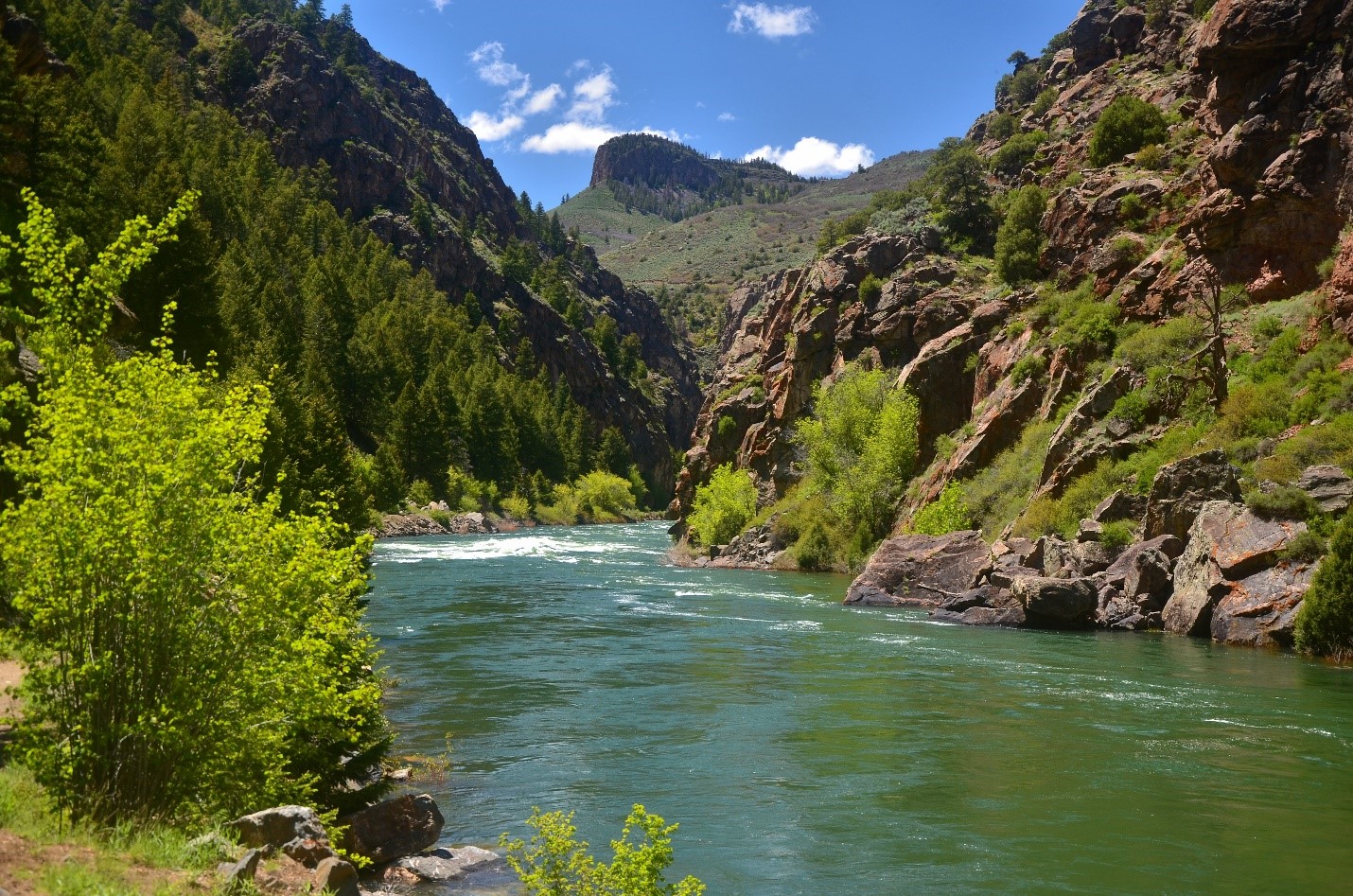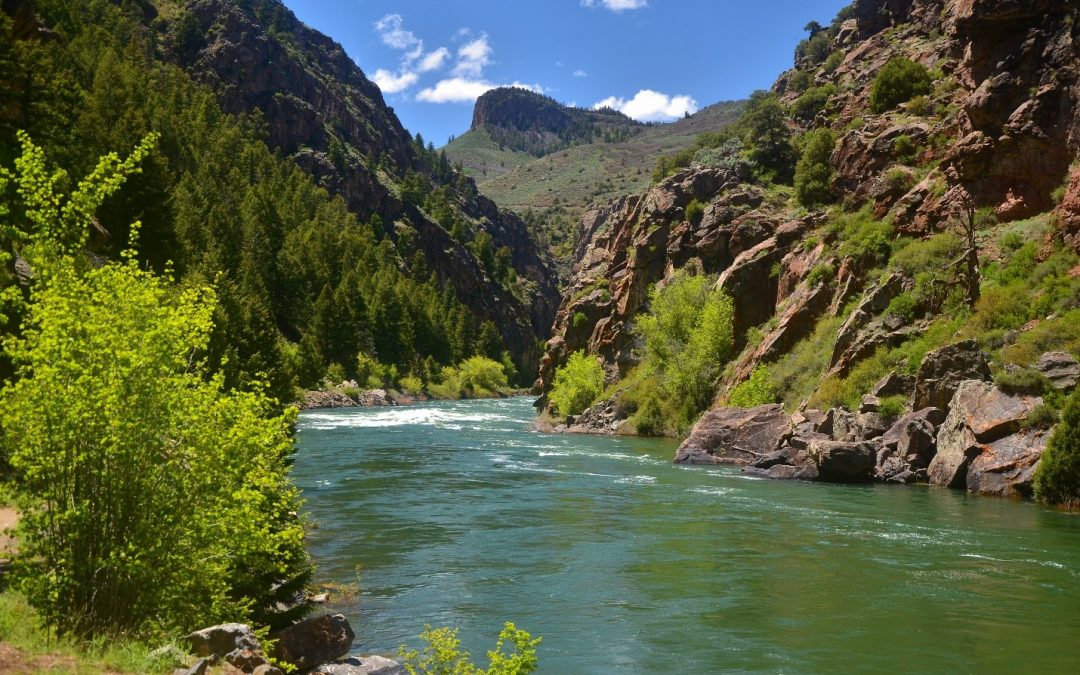By Jamie Duvall

Image Source: Gunnison River, Curecanti NRA by Tony Fernandez
Turns out it takes more than just luck to keep water flowing through Colorado’s rivers. Colorado’s instream flow program has protected streamflow conditions and provided flexible use options to water right owners for over 44 years. With its creation in 1973, the instream flow program gave the Colorado Water Conservation Board (CWCB) the unique ability to hold instream flow rights—water rights with the sole purpose of preserving the natural environment by remaining in streams or lakes. Since 1973, the program has contributed to the preservation of more than 9,700 miles of stream and 480 natural lakes by acquiring water rights and appropriating them for instream use.
As administrator of the instream flow program, the CWCB receives recommendations for water rights to be appropriated to specific lakes or reaches of stream. The CWCB then reviews these recommendations by conducting hydrological analyses to determine whether a specific appropriation would sufficiently benefit the natural environment. With most streams already over-appropriated—meaning that they have associated water rights whose sum exceeds the actual quantity available in the stream—the CWCB must acquire senior water rights if instream flows are to be effective. Senior water rights appropriated as instream flows will then remain in stream. The CWCB acquires these water rights through the Water Acquisitions Program – a program that, since 2012, has been facilitated by the Colorado Water Trust.
In partnership with the CWCB, the Colorado Water Trust uses market-based solutions to acquire water rights from willing owners—giving them the option to donate, sell, lease or loan their water rights on a permanent or temporary basis. When the Colorado Water Trust and CWCB first partnered in 2012, drought conditions were threatening aquatic ecosystems and recreational industries across the state. During their first collaborative year, the Request for Water Acquisitions program compensated water owners to maintain flows along the Yampa River, Fraser River, Deep Creek, Colorado River, White River, and Tomichi Creek. The Yampa, having received an allocation of 26 cfs for 76 days, was able to maintain low water temperatures and high flows during its peak recreational season. That said, the instream flow program, and its supporting voluntary Water Acquisitions Program, has been responsible for many success stories across our state.
Despite the historic success of this program, staff at the CWCB and Colorado Water Trust see room for improvement. This spring, the CWCB and the Colorado Water Trust have launched the Request for Water Acquisitions Pilot Process. With its launch, the two entities aim to achieve the following goals, highlighted in their Program Overview:
- to invite voluntary water right offers for streamflow benefits from willing water rights owners;
- to provide a user-friendly mechanism for water right owners to explore working with CWCB and the Water Trust on water acquisition transactions;
- to streamline transaction processes and utilization of resources;
- to facilitate implementation of Colorado’s Water Plan objectives; and
- to add flows to river segments in need while coordinating with agricultural and other uses.
The Request for Water Acquisitions Pilot Process introduces an annual deadline for owners to offer their water rights to the Instream Flow Program, clear criteria regarding what water rights are appropriate for the program, and approximate timelines for each transaction option available to the water rights holders. Offers submitted to the Colorado Water Trust by this year’s deadline of April 30th are considered preliminary and will not commit owners to pursuing a transaction. They will be reviewed free of charge, kept confidential, and responded to with a summary of available flow transactions by August.

Source: Colorado Water Trust, 2018 Request for Water Acquisitions Pilot Process Timeline: http://www.coloradowatertrust.org/images/uploads/resources/RFWA_2018_Process_Timeline.pdf
With the shortest timeline for transaction development expected to take six months, the impact of this new process is unlikely to be realized in 2018. However, with a potentially dry summer right around the corner, Coloradoans should find hope in the successes that this program has already demonstrated and the likelihood of more successes to come.
For water rights owners interested in making an offer during the 2018 pilot process, the Colorado Water Trust has established the following criteria:
- Will consider direct flow or storage water rights;
- Decreed diversion rate greater than 0.5 cfs;
- Storage rights greater than 20 acre feet;
- Must be relatively senior in priority to other water users on a stream;
- Must have a history of recent, continuous use;
- Cannot be on the Division Engineer’s abandonment list;
- No conditional water rights;
- No groundwater or spring rights;
- Will consider water rights decreed for any beneficial use;
- Irrigation rights must be willing to dry up associated lands during implementation periods;
- Will consider storage water delivery contracts; and
- Will consider partial or split season uses.
Additionally, following the April 30th deadline for preliminary offers, the Colorado Water Trust will begin confidential water rights investigations, assessments of potential streamflow benefits, and the identification of transaction of options. By July 31st, water rights owners can expect a response to their preliminary offer. From there, contract development timelines vary depending on the transaction:
- 6 months for water conservation programs;
- 8-10 months for short term leases (5/10 consecutive years);
- 2-3 years for long term leases (10+ years); and
- 2-3 years for permanent water right transfers.
For more information, visit the Colorado Water Trust’s webpage or watch a recent webinar from the water trust here
 Jamie graduated from the University of Colorado Boulder in 2017 with a double major in Environmental Studies and Geography. Having always known that she wanted to work with water resources, Jamie has studied many related topics such as hydrology, water law, watershed management, GIS, and even permaculture design. She currently works for a local residential restoration company and has played an important role in its management for the past six years. This article represents her intentional transition into the industry of water resources and into a career path that closely aligns with her values.
Jamie graduated from the University of Colorado Boulder in 2017 with a double major in Environmental Studies and Geography. Having always known that she wanted to work with water resources, Jamie has studied many related topics such as hydrology, water law, watershed management, GIS, and even permaculture design. She currently works for a local residential restoration company and has played an important role in its management for the past six years. This article represents her intentional transition into the industry of water resources and into a career path that closely aligns with her values.


 Print
Print
Reblogged this on Coyote Gulch.